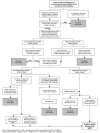Use of a cancer registry is preferable to a direct-to-community approach for recruitment to a cohort study of wellbeing in women newly diagnosed with invasive breast cancer
- PMID: 18454846
- PMCID: PMC2396174
- DOI: 10.1186/1471-2407-8-126
Use of a cancer registry is preferable to a direct-to-community approach for recruitment to a cohort study of wellbeing in women newly diagnosed with invasive breast cancer
Abstract
Background: Breast cancer (BC) mortality is declining such that the number of survivors of BC in the community is increasing. BC survivors report a range of sequelae from their cancer and its management beyond the period of their immediate treatment. Previous studies to document these have generally been small, clinic-based or commenced years after diagnosis. We have recruited a large cohort of women newly diagnosed with invasive BC from the community who will be followed for five years in order to systematically document the physical, psychological and socio-economic consequences of BC and its treatment. The aim of this manuscript is to describe the issues encountered in the recruitment of this community-based study population.
Methods: Women residing in the southern Australian state of Victoria newly diagnosed with invasive BC were recruited to this cohort study using two approaches: directly from the community using an advertising campaign and contemporaneously using an invitation to participate from the Victorian Cancer Registry (VCR).
Results: Over the two and half year recruitment period, 2135 women were recruited and agreed to receive the enrollment questionnaire (EQ). Of these, 1684 women were eligible and completed an EQ, with the majority of participants having been recruited through the VCR (n = 1321). Only 16% of women contacted by the VCR actively refused participation following a letter of invitation and phone follow-up. The age distribution and tumour characteristics of participants are consistent with state-wide data and their residential postcodes include 400 of a possible 699. Recruitment through a direct community awareness program aimed at women with newly diagnosed invasive BC was difficult, labour-intensive and expensive. Barriers to the recruitment process were identified.
Conclusion: Most of the women in this study were recruited through a state-based cancer registry. Limitations to recruitment occurred because we required questionnaires to be completed within 12 months of diagnosis in a setting where there is several months delay in notification of new cases to the Registry. Characteristics of the cohort suggest that it is generally representative of women in the state of Victoria newly diagnosed with BC.
Figures
Similar articles
-
Psychological well-being in a cohort of women with invasive breast cancer nearly 2 years after diagnosis.Support Care Cancer. 2010 Aug;18(8):921-9. doi: 10.1007/s00520-009-0726-z. Epub 2009 Aug 26. Support Care Cancer. 2010. PMID: 19707799
-
Assessment of Breast Cancer Mortality Trends Associated With Mammographic Screening and Adjuvant Therapy From 1986 to 2013 in the State of Victoria, Australia.JAMA Netw Open. 2020 Jun 1;3(6):e208249. doi: 10.1001/jamanetworkopen.2020.8249. JAMA Netw Open. 2020. PMID: 32573707 Free PMC article.
-
Format and readability of an enhanced invitation letter did not affect participation rates in a cancer registry-based study: a randomized controlled trial.J Clin Epidemiol. 2013 Jan;66(1):85-94. doi: 10.1016/j.jclinepi.2012.07.016. Epub 2012 Oct 25. J Clin Epidemiol. 2013. PMID: 23102853 Clinical Trial.
-
In situ and small invasive breast cancer register in Victoria, 1988 to 1992: tumour characteristics and patient management.ANZ J Surg. 2001 May;71(5):266-70. doi: 10.1046/j.1440-1622.2001.02100.x. ANZ J Surg. 2001. PMID: 11374473
-
Recruitment of representative samples for low incidence cancer populations: do registries deliver?BMC Med Res Methodol. 2011 Jan 16;11(1):5. doi: 10.1186/1471-2288-11-5. BMC Med Res Methodol. 2011. PMID: 21235819 Free PMC article.
Cited by
-
The relationship between knowledge of family history and cancer characteristics at diagnosis in women newly-diagnosed with invasive breast cancer.Fam Cancer. 2009;8(4):299-305. doi: 10.1007/s10689-009-9236-x. Epub 2009 Feb 17. Fam Cancer. 2009. PMID: 19221894
-
Recruitment of a Population-Based Sample of Young Black Women with Breast Cancer through a State Cancer Registry.Breast J. 2016 Mar-Apr;22(2):166-72. doi: 10.1111/tbj.12545. Epub 2015 Dec 14. Breast J. 2016. PMID: 26661631 Free PMC article.
-
Psychological well-being in a cohort of women with invasive breast cancer nearly 2 years after diagnosis.Support Care Cancer. 2010 Aug;18(8):921-9. doi: 10.1007/s00520-009-0726-z. Epub 2009 Aug 26. Support Care Cancer. 2010. PMID: 19707799
-
Changes in patterns of use of cigarettes and alcohol in women after a first diagnosis of invasive breast cancer: a cohort study of women from Victoria, Australia.Support Care Cancer. 2012 Apr;20(4):783-9. doi: 10.1007/s00520-011-1150-8. Epub 2011 Apr 9. Support Care Cancer. 2012. PMID: 21479524
-
Testing a Population-Based Outreach Intervention for Ovarian Cancer Survivors to Encourage their Close Relatives to Consider Genetic Counseling.Cancer Epidemiol Biomarkers Prev. 2024 Sep 3;33(9):1185-1193. doi: 10.1158/1055-9965.EPI-24-0147. Cancer Epidemiol Biomarkers Prev. 2024. PMID: 38912902 Free PMC article. Clinical Trial.
References
-
- Australian Institute of Health and Welfare (AIHW) and Australasian Association of Cancer Registries (AACR) Cancer survival in Australia 2001. Part 1: National summary statistics. AIHW cat. no. CAN 13 , AIHW (Cancer Series no. 18); 2001.
-
- The Cancer Council Victoria . Breast (female) Cancer Survival 2007 , 42-43; 2007.
-
- Centers for Disease Control and Prevention Cancer survivorship-United States, 1971-2001. MMWR - Morbidity & Mortality Weekly Report. 2004;53:526–529. - PubMed
Publication types
MeSH terms
LinkOut - more resources
Full Text Sources
Medical


